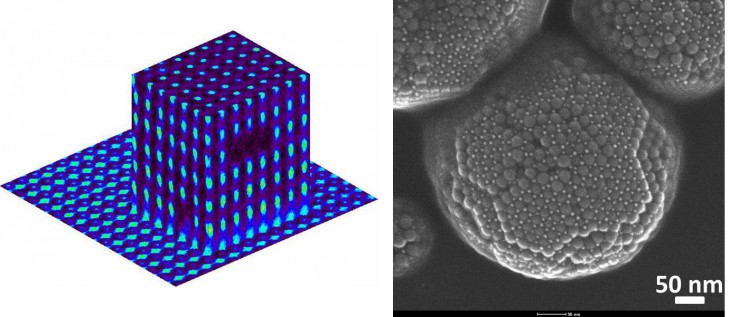Soft Condensed Matter
Prof.dr. Alfons van Blaaderen
Self-Assembly (SA) or Self-Organization of colloidal model particles is a central theme in our group. Not only do we develop new colloidal model systems with (several) SA steps in mind, we also develop methodologies to study and manipulate such processes with the use of external fields. Examples of the fields we use in our research are: gravity, structured walls (e.g. colloidal epitaxy), confinement, electric fields (including light: optical tweezers) and (shear)flow. Recently, combinations of two or more external fields and their use in so-called hierarchical SA processes are exciting new research directions. An example of hierarchical SA is shown in the figure below where a binary colloidal crystal of magnetic (iron-cobaltoxide) and metal (gold) nanoparticles is shown after it self-assembled through slow drying of a dispersion of these nanoparticles in an oil-in-water emulsion. Such SA in a spherical confinement results in a so-called ‘supraparticle’ and is different from SA in the bulk because of the spherical confinement. The formation of such supraparticles is also is an example of arrested SA as it allows for further SA steps as the size of the supra-particles formed is still in the colloidal domain. A next SA step could for instance lead to a photonic crystal like the example of micron-sized fluorescently labeled silica particles crystallized on top of a structured polymer template shown in the same figure on the left. Another new direction we are heading in with SA is the use of so-called active or driven particles that do not rely on Brownian motion alone to form new kinds of structures.
Although we certainly also use scattering methods to characterize the processes and structures that result from SA, our strength is in the development of ways to analyze these in real space. Already in the early 90’s of the previous century we pioneered the use of confocal microscopy in quantitatively determining the coordinates of thousands of micron-sized particles. Presently, light microscopy is truly transforming into nanoscopy with commercial confocal microscopes already available with resolutions well below 100 nm enabling many new opportunities. In addition, we have started using electron microscopy to extend our real space analysis to that of atoms in nanoparticles and nanoparticle coordinates inside structures of such particles. It is a challenging but quite rewarding effort to try to combine these real space techniques with the external fields mentioned and not only for static structure, e.g. determining radial distribution functions for nanoparticles, but also to follow dynamics.
The concept of core-shell morphologies to decouple particle properties from for instance inter particle interactions remains a strong way to design new particles. However, more complex particle shapes, interactions (e.g. patchy particles) and self-assembled structures, including the already mentioned supraballs, are being explored. Giving particles functionality that can be addressed by external triggers is another approach that adds to new ways to control the arrangement of matter in space. Examples of this include shells containing particle cores that can be moved by an external field inside the shells and chemicals that can be transported into or out of such shells for instance by the action of surfactants.

Left: Confocal 3D data set of micrometer-sized fluorescently labeled silica spheres crystallized on a structured polymer substrate (colloidal epitaxy). Right: Binary supraball assembled in a drying emulsion droplet containing gold and iron-cobaltoxide nanoparticles
Model colloids will remain a powerful model system to address fundamental questions from condensed matter physics such as the role of rotational degrees of freedom in crystallization and the glass transition. However, their role as model is expanding recently also in studies (much) further away from equilibrium. Examples we recently explored are pattern formation under the influence of an external electric field, and the already mentioned self-propelled particle systems.
It is hard to overestimate the importance for our society that came with our ability to exert control over the placement of certain atoms in materials (such as in the doping of silicon single crystals and the modification of iron into steel). Our ability to structure matter on multiple length scales is still quite immature, but it is our belief that with an increase in our ability to do so come similar great opportunities. Opportunities that we may only hope to be a small part of.
Key publications
- B. Liu, T. H. Besseling, M. Hermes, A. F. Demirörs, A. Imhof, and A. van Blaaderen, Nature Communications, 5 (2014), 3092, ‘Switching plastic crystals of colloidal rods with electric fields’.
- M.E. Leunissen, C. G. Christova, A.-P. Hynninen, C. P. Royall, A. I. Campbell, A. Imhof, M. Dijkstra, R. van Roij, and A. van Blaaderen, Nature 437 (2005), 235-240, “Ionic colloidal crystals of oppositely charged particles”.
- A. Yethiraj and A. van Blaaderen, Nature 421 (2003), 513-517, “A colloidal model system with an interaction tunable from hard sphere to soft and dipolar”.
